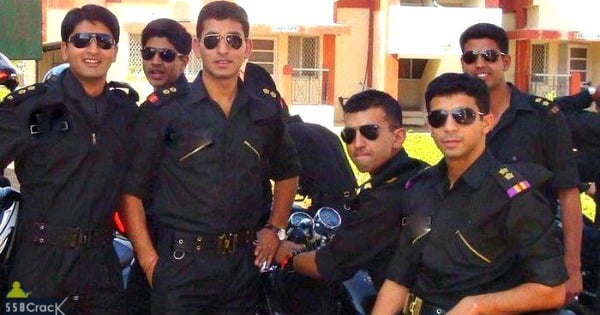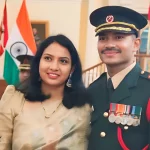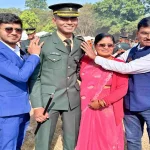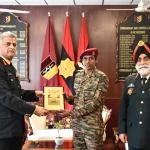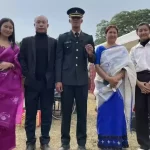It’s a golden afternoon at the Kulattur Reserve Forest on the fringes of Chennai. The searing sun casts a surreal glow on the clearing in the middle of nowhere. Assembled in camouflage uniforms are over 200 Gentleman Cadets (GC) and Lady Cadets (LC), their faces tired, limbs brown, bodies erect, despite the 17-kg backpack that holds battle gear and a five-kg rifle, and spirits upbeat. Maps are consulted, compasses aligned, and with deafening shouts of “Fighter! Fighter! Phillora”, the first of the seven companies that cadets are inducted into on joining the Officers Training Academy (OTA), begins its 40-km run through scrub jungle.
The navigational endurance exercise is the last of a four-day camp designed to never allow cadets more than a few minutes rest in bivouacs. “It is also the final leg of a training ritual that tests more than just fitness. The emphasis is on camaraderie and character — qualities that drive you to keep going when every instinct is to give up,” says Col. Renjy George, head of the training team, who oversees the action with his keen-eyed commanders.
Each company, named after a battle the Army has fought, has to carry out a timed run through the jungle, aided by a compass, map and radio set, and touch base with six checkpoints that offer just oral rehydration salts and a quick change of socks. But as the evening wears on and darkness and exhaustion set in, there are other dangers to contend with, such as snakes, blind wells and misread contours. When the race reaches the final leg, in the wee hours of the morning, the yells of encouragement and rasping groans rise to a crescendo. There is enthusiastic cheering among the winners; the losing company collapses dejectedly. A GC limps back, his buddy resolutely jogging under the combined weight of both their backpacks; an LC holds up her bleeding arm.
For over 52 years now, OTA has been one of Chennai’s best-kept secrets. Established in 1963 to train officers for Emergency Commission in the Army, it now trains those between 22 and 25 years for the Short Service Commission. It is also the only Academy, among the country’s four Army training establishments, which commissions women to be officers.
Standing at the bend of GST Road, at the foot of St. Thomas Mount, OTA marks its place in our city’s conscience perhaps twice a year, when the Passing-Out Parade is held or when one of its alumni, such as the late Maj. Mukund Varadarajan AC, is recognised for valour beyond the call of duty. Otherwise, the sagas of extraordinary resilience and unflagging energy that are written here in the 49 weeks it takes to earn a Lieutenant’s stars rarely filter through.
As the car wheezes its way up the metalled road to ‘P(unishment) Hill’, I see cadets run cross-country through the red mud path that spirals to the peak on the other side. Below lies the 750-acre Academy, its broad tree-lined avenues — filled with cadets cycling or walking in threes — branching off from the Ram Singh Dwar, named after its first Commandant, Brig. Ram Singh. The history of the Madras Presidency army echoes through the colonnaded verandahs of the White House, built in 1861, which serves as the headquarters and office of the Commandant, and Flag Staff House (1928), the residence of the Commandant, at present Lt. Gen. Ravindra Pratap Sahi AVSM.
The company barracks stand at the foot of the hill. Cadets reside in individual rooms and are subject to surprise kit inspections, but living in the barracks also fosters esprit-de-corps. Maj. Vineeth, a platoon commander in charge of training, says, “There are 70-80 cadets and four-five officers per company. Six foreign cadets are being commissioned this time. Each officer is closely involved with the cadets under him, from the time he or she wakes up to the time it’s lights out. Transforming a person from civvy street to being fighting fit, and pushing him to excel physically in Chennai’s sapping humidity is challenging. By the end of two terms, all cadets are on a par and the Army’s honour code is ingrained in them. Once in uniform, their economic, social and cultural barriers melt away.”
Across the road stands the grand Adyar Officers’ Mess built in 1815, at the end of the Napoleonic Wars. And everything on campus — the crest that hangs in the drill square, the cadets’ ties and the crockery — bears the colours of the Academy, steel grey and blood red. On it are emblazoned two cross-swords and Ashoka’s dharma chakra with the motto ‘Serve With Honour’.
Further afield lie the PT grounds, the drill square, the classrooms, the firing range and the games fields where another motto reigns — he who sweats, wins. A schedule of unmatched rigour begins with hooters blaring at the crack of dawn. Cadets line up in white T-shirts and shorts and, from a distance, it is difficult to tell a GC from an LC as all of them sport the ‘zero cut’ — a little more than an inch of hair on their heads. As the cadets shimmy up the vertical rope, monkey crawl on the horizontal one and perform leaps of faith across the ditch for the next 45 minutes, they are guided by a team of physical instructors, headed by the Physical Training Officer, Col. Sanjay. He says, “Through a scientific process we make cadets physically and mentally tough to take the stress of battle. They complete the Battle Proficiency and Efficiency Test and the confidence-building Assault Course. Reaction ability and mental grit cannot be taught in a gym.”
The drill instructor is often the cadet’s first window to military life. His no-nonsense demeanour and pace stick (resembling a divider) that measures length of pace while marching are enough to shake the lackadaisicalness out of cadets and mould them into Army shape.
It’s the day of the inter-company drill competition and the Academy resounds with the clash of rifle butts and flash of gilt-edged swords in a ceremonial spectacle of precision marching and parade commanding.
After a hurried breakfast at the Yoddha Cadets’ Mess where the portraits of Indian Presidents line the walls, cadets cycle to the Gaur Academic Block or to the Lecture Demonstration stands, where they study subjects ranging from military history and martial law to weapon training and science and warfare. When they graduate, apart from the President’s Commission, cadets also earn a PG Diploma in Defence and Strategic Studies from the University of Madras.
A little over a year ago, the senior-most cadet, Academy Under Officer Anjana M., a 25-year-old law graduate from Mumbai and a post-graduate in dance, was working in a glass-and-chrome office. But she swapped her black robes and long hair for the uniform. “My parents were thrilled. I’m a Judge Advocate-General entrant, so I will be able to continue a career in law. Having been a Bharatanatyam dancer for years, a zero cut was something I had to get used to,” she smiles. “But it makes tremendous sense, especially when you train in summer.”
City boy and Academy Cadet Adjutant S. Vignesh, an engineer, worked with a power plant company before signing up. “My family encouraged me. The day I got my zero cut I was elated — I knew I was on the path to becoming an officer. There is never a dull moment, as training is so structured and varied, and there are many club activities.”
On Sundays, cadets are given ‘liberty’ and issued out-passes. “I go home,” says Vignesh. “But many prefer to ready their dresses or clean their weapons.”
As important as the military skills, are the indefinable virtues that go into making an officer and a gentleman — leadership potential and the courage to lead in battle. For that, the cadets draw inspiration from the Academy’s numerous alumni — from Maj. R. Parameshwaran PVC who continues to live on in the drill square named after him to Lt. N. Parthiban KC after whom the gym is named.
Their valour is remembered at the moving memorial service where officers, cadets and relatives of martyrs lay wreaths. And so, while the Last Post echoes from the buglers atop P Hill, and silent tears roll down cheeks, cadets pray for the same fortitude when tested in the “forge of battle”.
This morning at the Passing-Out Parade, as cadets slow-march towards the Antim Pag (Final Step), in a shower of rose petals to the tune of ‘Auld Lang Syne’, it will mark more than a rite of passage from cadet to officer. As their boots glide in quiet synchrony and the stars ride up their epaulettes, they can look back with pride at having outlasted the most challenging education money cannot buy.
Lt. Gen. R.P. Sahi AVSM, Commandant, OTA, on building warriors for tomorrow’s battlefields:
Nature of training: Our aim is to create proficient leaders, but the methodology and content of training have changed to keep pace with technology and the way wars are now fought. Many join the Academy after having pursued a different profession; therefore, they are more aware and mature. But there is a definitive fall in physical capability, and our training has been moulded accordingly so that they accomplish the expected standards in a shorter time-frame.
The Lady Cadet: Donning the uniform has been a dream for all of them; many have defied the wishes of their families to join.
Vacancies are restricted to approximately 40 LCs and only the cream is chosen.
The curriculum: It covers every aspect of soldiering, including battle inoculation, and ensures that cadets are well acquainted with every kind of terrain and operation they are likely to encounter.
Choice of regiment: Cadets fill in three choices for allotment of arms and services. We endeavour to honour individual choice — 90 per cent of cadets get their first or second choice — but organisational interest is primary.
Merit and parental claim, where any cadet whose father has been the Commanding Officer or Subedar Major of a unit wishes to join the same, are also considered.
Exchange programmes: A robust cadet exchange programme exists with a number of pre-commission training academies in the U.K., Australia, Thailand, Bangladesh and Singapore.
Access to public: The Academy accepts requests for visits by educational institutions and permits students to witness ceremonial parades.
Source: thehindu.com

